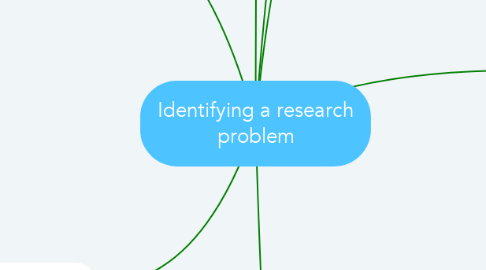
1. Differ
1.1. To better understand research problems, you might distinguish them from other parts of the research process.
1.2. -The research topicis the broad subject -The purpose is the objective of the study -The research question narrows the purpose to an specific question
1.3. They differ in terms of breadth from broad to narrow, the research problem is not the purpose.
2. What is better to use?
2.1. quantitative
2.1.1. Use quatitative if your research problem requires to you -measure variables -Assess the impact of these variables on an outcome -Test theories or broad explanations - Apply results to a large numberof people
2.2. Qualitative
2.2.1. Tend to use qualitative research if your research problem requires you : -Learn about the views of individuals -Assess a process over time -Generate theories based on participant perspective -Obtain detailed information about a few people or research sites
3. Can and should
3.1. Just because a problem exist, it doesnt mean that the researcher can investigate it, we need:
3.1.1. access to the people and sites
3.1.2. time
3.1.3. resources
3.1.4. skills
3.2. Should we research that?
3.2.1. Study the problem if your study will fi ll a gap or void in the existing literature
3.2.2. Study the problem if your study replicates a past study but examines different participants and different research sites
3.2.3. Study the problem if your study extends past research or examines the topic more thoroughly.
3.2.4. Study the problem if your study gives voice to people silenced, not heard, or rejected in society.
3.2.5. Study the problem if your study informs practice.
4. Why is important?
4.1. it sets the stage for the entire study
4.2. People must acknowledge what is the importance of your research
5. What is it ?
5.1. Are the educational issues, controversies, or concerns that guide the need for conducting a study
6. writing strategies
6.1. a template
6.1.1. divie the topic in five paragraphs addressing five aspects of the topic
6.2. use of multiple references to build credibility
6.3. Quote participants in similar studies
7. Writing the statement of the problem
7.1. The topic
7.1.1. The topic of the whole writing we have to go from the broad to the specific.
7.1.2. To open your research it must be explained with a general idea that can be easy for the reader and engaging
7.1.3. We can start with
7.1.3.1. stadistical data
7.1.3.2. a provocative question
7.1.3.3. a clear need of research
7.1.3.4. the purpose of the study
7.2. The Research Problem
7.2.1. Authors may present it as a single sentence or as a couple of short sentences.
7.2.2. Types
7.2.2.1. practical research problems
7.2.2.2. research-based research problem
7.2.2.3. or both
7.3. Justification
7.3.1. Tell the reader why is the issue important
7.3.2. Can be in different paragraphs citing
7.3.2.1. other researchers
7.3.2.2. experiences others have
7.3.2.3. personal experiences
7.4. deficiencies
7.4.1. defi ciencies in the research may require a need to extend the research, replicate a study, explore a topic, lift the voices of marginalized people, or add to practice
7.4.2. A defi ciency in practice means that educators have not yet identifi ed good and workable solutions for schools or other educational settings.
7.5. Audience
7.5.1. You have to always think about what is the people that is gonna read your work
7.5.2. several often considered by educators include researchers, practitioners, policy makers, and individuals participating in the studies.
